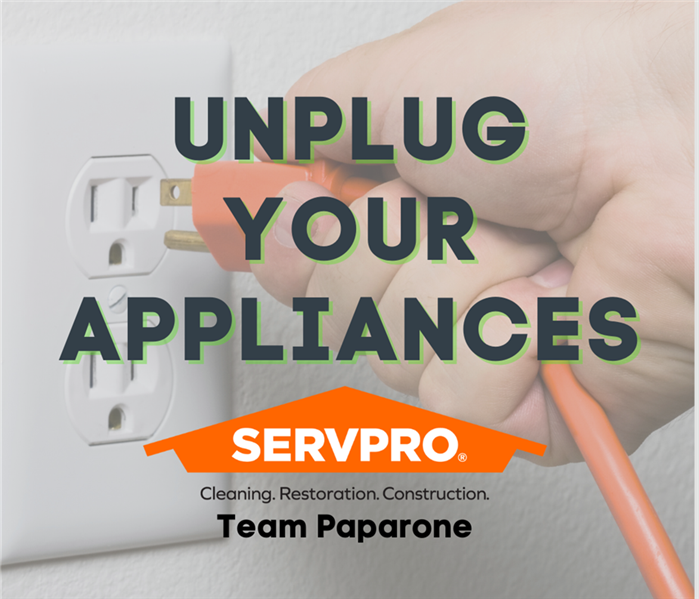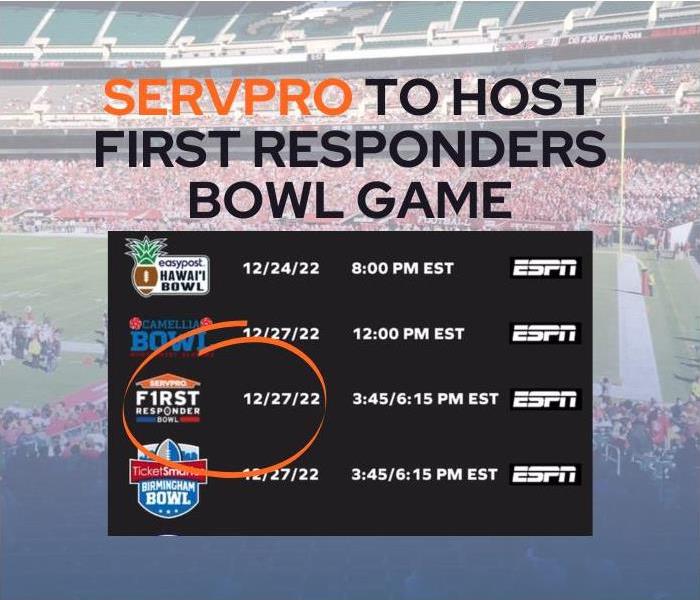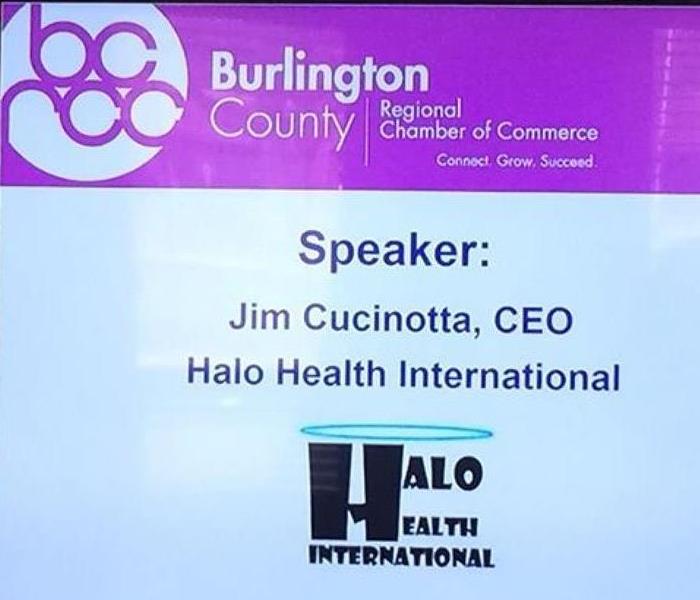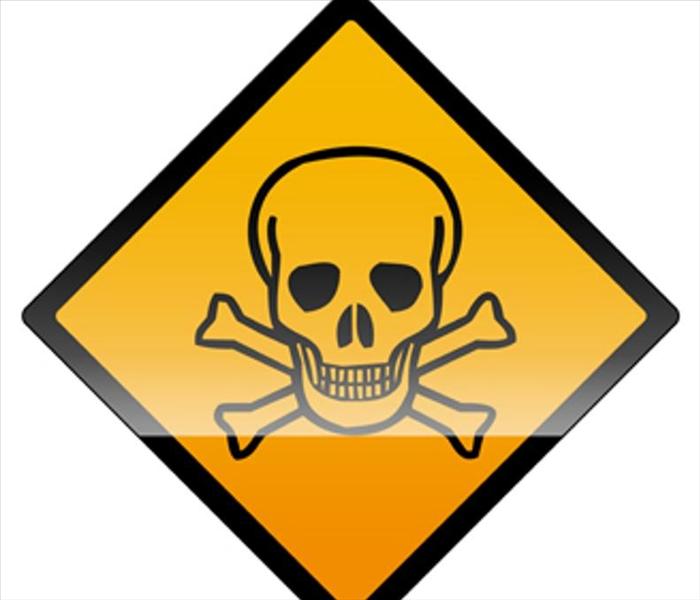Recent General Posts
6 Tips to Protect Your Burlington Home While on Vacation
7/20/2023 (Permalink)
Many people go on vacations during the summer months, leaving their properties unattended. SERVPRO is the #1 choice in restoration services to property owners, property managers, and vacation rental agencies. The need for routine inspections, maintenance, and restoration is very important to prevent any potential damage while the properties are vacant.
Here are some tips to make sure your property is taken care of while you’re relaxing!
- Secure doors and windows: Before leaving, double-check that all doors, windows, and entry points are securely locked. You don’t want water to make its way uninvited.
- Inform trustworthy neighbors or friends about your vacation plans. Provide them with your contact information and ask them to keep an eye on your property.
- Maintain your property's exterior: Before leaving, ensure that your property's exterior is well-maintained. Trim trees and bushes, mow the lawn, and remove any potential hazards or debris that could cause damage during your absence.
- Unplug non-essential appliances: To prevent electrical fires or power surges, unplug non-essential appliances, such as computers, TVs, and kitchen appliances. This also helps conserve energy while you're away.
- Check water sources: Turn off the main water supply or shut off individual water valves to prevent leaks or flooding. Consider installing leak detection devices that can alert you to any water leaks or pipe bursts.
- IF EMERGENCY OCCURS: Inform your security company and emergency contacts, such as SERVPRO of Burlington Twp./Mt. Holly. We are available 24/7.
Vacation is supposed to be a relaxing getaway from reality. Performing these tips and tricks will help your family have a stress-free trip!
SERVPRO Hosts The First Responders College Bowl Game
9/16/2022 (Permalink)
It’s that time of year! Football season is upon us and SERVPRO hosts The First Responders College Bowl Game on December 27th in Dallas, Tx. SERVPRO takes pride in supporting their local first responders and SERVPRO of Society Hill is proud to be a part of that initiative.
SERVPRO has been sponsoring the bowl game since 2014 and has given our franchises the opportunity to honor local first responders on a national level. Rick Isaacson, CEO of SERVPRO, said, “The SERVPRO First Responder Bowl is one way we celebrate these dedicated first responders and their families as the hometown heroes they are.”
Each franchise will nominate a local first responder to be considered for special recognition at this year's game. One nominee will be selected to experience an all-expenses-paid trip to the game where they will be presented with an award.
The SERVPRO First Responders Bowl also has a virtual Everyday Heroes Wall that honors these courageous people in our community. If you know someone who has committed to risking their lives every day, view the Everyday Heroes Wall page to submit a photo of your frontline hero!
Burlington County Event
3/1/2017 (Permalink)
Thank you to the Burlington County Regional Chamber of Commerce for the educational lunch and learn. We enjoy attending each month and look forward to seeing you all again next month.
SERVPRO Goes Pink for October: Breast Cancer Awareness Month
10/5/2016 (Permalink)
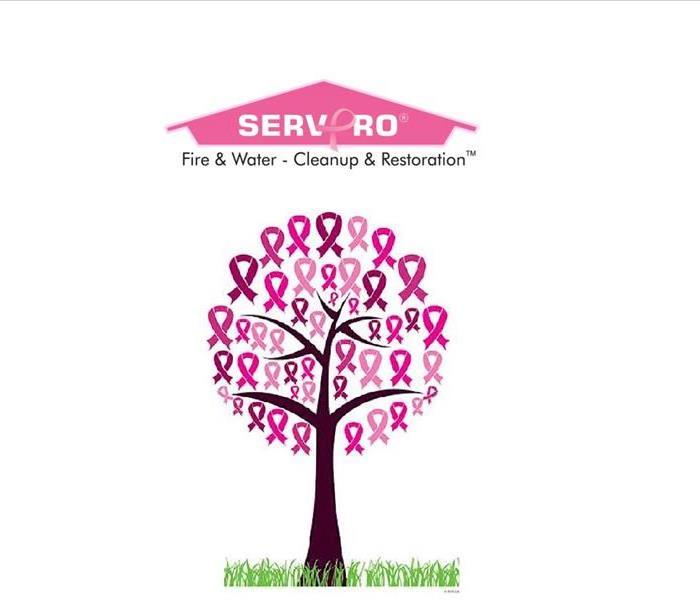 BCRF Susan G Komen SERVPRO Pink October Breast Cancer Awareness and Research
BCRF Susan G Komen SERVPRO Pink October Breast Cancer Awareness and Research
October is breast cancer awareness month. Every year, more than 100,000 volunteers and activists work through more than 120 Affiliates mobilize more than 1.6 million friends and neighbors every year through events like the Susan G. Komen Race for the Cure® - the world's largest awareness and fundraising event for breast cancer. Komen advocates for breast self-awareness as a primary method for fighting breast cancer.
The Breast Cancer Research Foundation is a nonprofit organization committed to achieving prevention and a cure for breast cancer. We provide critical funding for cancer research worldwide to fuel advances in tumor biology, genetics, prevention, treatment, metastasis and survivorship.
In 2016-2017, BCRF will award $57 million in annual grants to more than 250 scientists from top universities and medical institutions around the globe. In addition, BCRF has established the Evelyn H. Lauder Founder’s Fund, a multi-year international program dedicated to metastasis that is the first large-scale global effort to unravel the biology of metastasis, with more than $30 million earmarked to date. It is the largest privately funded project exclusively focused on metastasis in the world. But we still have more to do.
Funeral Service Directors: SERVPRO can help your business grow
9/21/2016 (Permalink)
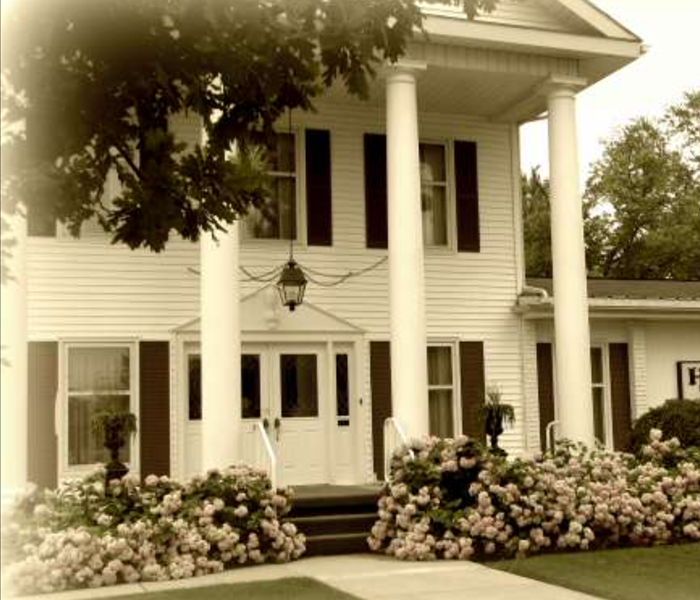 SERVPRO can help Funeral Service Companies and Funeral Directors or Funeral Homes
SERVPRO can help Funeral Service Companies and Funeral Directors or Funeral Homes
SERVPRO attends many events throughout or workweek. Next week we have a benefit sponsoring the families of injured or sick emergency workers. This past week, we sponsored an event for funeral homes and funeral directors.
We learned about those businesses and enjoyed meeting many different people who are experts in the funeral industry. We also were able to demonstrate our services that funeral homes often are in need of but don't typically know we offer.
We can offer bio-recovery and cleanup. Last week we provided service to a building where someone who lived alone passed away and was not found until several days later. Situations like that need to be handled specially and we just recently completed a week long training course to be certified in bio-recovery cleanup.
Many families are also faced with the task of moving out their loved ones' possessions. We offer pack out and move out services as well as removal of trash and cleanup of properties.
Funeral homes often find theirselves helping families grieve and get through the process respectfully. Knowing they are able to call on the SERVPRO professionals helps them grow their businesses and provide great service.
SERVPRO makes National Preparedness Month Easy: Make Your Emergency Plan With SERVPRO
9/14/2016 (Permalink)
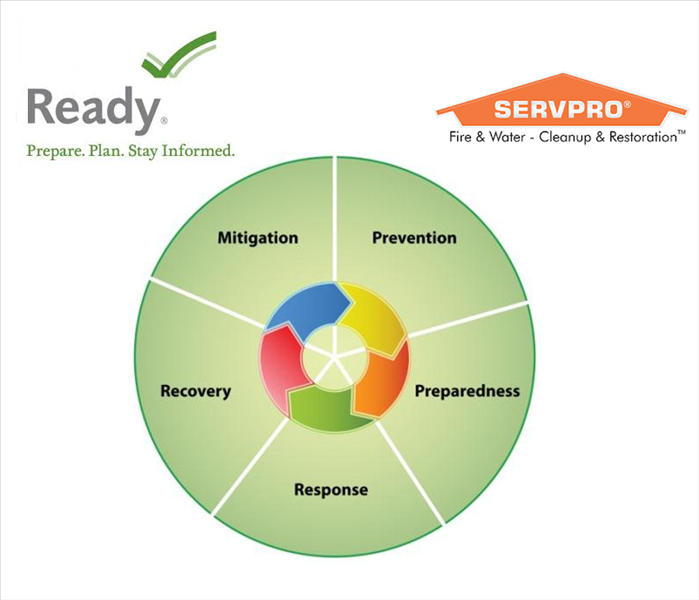 SERVPRO Makes National Emergency Preparedness Month Easy
SERVPRO Makes National Emergency Preparedness Month Easy
We are in the middle of hurricane season. Right now, Asia is experiencing a record-breaking typhoon, and here in the United States, September is recognized as National Preparedness Month which serves as a reminder that we all must take action to prepare, now and throughout the year for the types of emergencies that could affect us where we live, work and visit.
The theme of this year’s National Preparedness Month is “Don’t Wait, Communicate. Make Your Emergency Plan Today.” and suits well with everything we do at SERVPRO.
Did you know SERVPRO offers a FREE emergency ready profile that anyone can set up using a smartphone or tablet? SERVPRO has ensured making your emergency ready plan is available at the touch of your fingertips through our FREE app available in your app store. Visit ready.SERVPRO.com to learn more.
Of course, in the spirit of being prepared and ready for any disaster that could happen, we hope everyone adds SERVPRO to your contingency plans both at work and home. Protecting your home by knowing our services are available 24 hours a day, 365 days each year is a great way to stay prepared. Add our number to your plan: 215-772-1203 and make sure you download our ready app to create your emergency ready profile today!
Eastampton Township Youth Police and Fire Academy a Huge Success
9/7/2016 (Permalink)
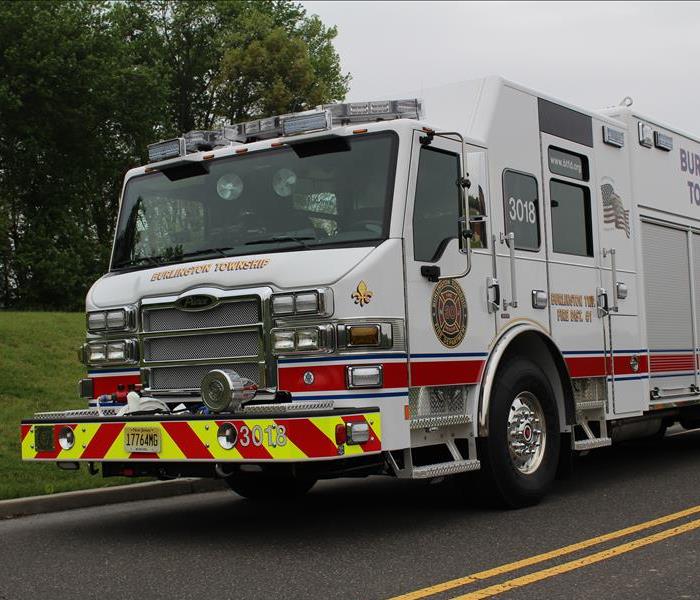 SERVPRO fire water restoration
SERVPRO fire water restoration
The Eastampton Township Police Department and Eastampton Township Fire Department co-sponsored the 1st annual Police and Fire Academy from August 15 – August 19. Based upon a motto of “Service Before Self,” the free academy graduated twenty-four (24) youth cadets who participated in a variety of law enforcement and emergency services activities. The program was made possible through the generous donations of several local businesses and organizations including Eastampton Township Council, Eastampton Fire Department, Eastampton Police Department, Eastampton Fraternal Order of Police Lodge #146, 537 Subs, O’Connor’s Restaurant, Russo’s Restaurant, Rancocas Veterinary, Six Flags, and Walmart of Lumberton. The program concluded with a ceremony in which participants received graduation certificates.
SERVPRO enjoys collaborating with police and fire departments to perform tasks they need for emergency services.
Two Easy Home Maintenance Tasks to Prepare for Fall and Prevent Water Damage
8/31/2016 (Permalink)
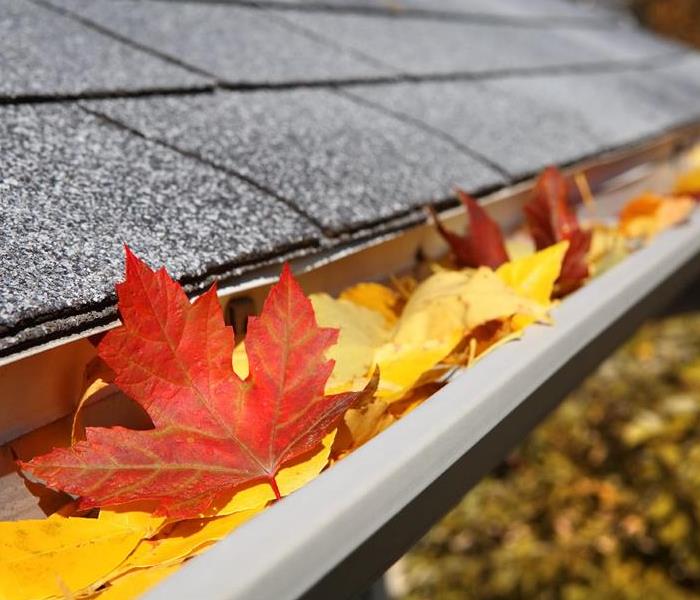 SERVPRO water restoration and cleanup
SERVPRO water restoration and cleanup
As much fun as summer can be, it has to end at some point. As the trees begin to change and the weather shifts from hot and humid to cool and crisp, it’s time to prepare for the onset of cooler months. Whether you’re not ready for the heat to be gone or are looking forward to unpacking your favorite cold weather clothes, there’s a lot to do to get ready for the changing seasons.
7. Inspect your roof
If you have a heavy rainstorm or a foot of snow, can your roof take the burden? Before settling in for another chilly fall and a freezing winter, take a look at your roof for weak spots, cracks in your shingles, granules, and wind damage. If you see anything that looks off or unstable, a roofer may be what your home needs to weather this winter’s storms.
3. Clean our your gutters
As the leaves begin to turn, you know you’re only weeks away from them falling off entirely and stopping up your gutters. Before you find yourself with a big mess on your hands, take the time now to clean out your gutters and drainpipes to prevent the possibility of water damage and clogs. A clean early in the season may not suffice through the winter, but it will make sure you’re prepared for the harsher weather to come. Water damages can be caused by clogged drains; overflowing water to collect on your roof or house and most outside water damage is not covered by insurance!
Preparing your house for fall may not be what you planned during the weekend, but it’s something you’ll thank yourself for later. With the right measures taken now, you and your family will be prepared to settle in for the fall and winter, no matter what may be coming your way.
SERVPRO Sponsors the 44th Biannual Pennsylvania Fraternal Order of Police Conference
8/10/2016 (Permalink)
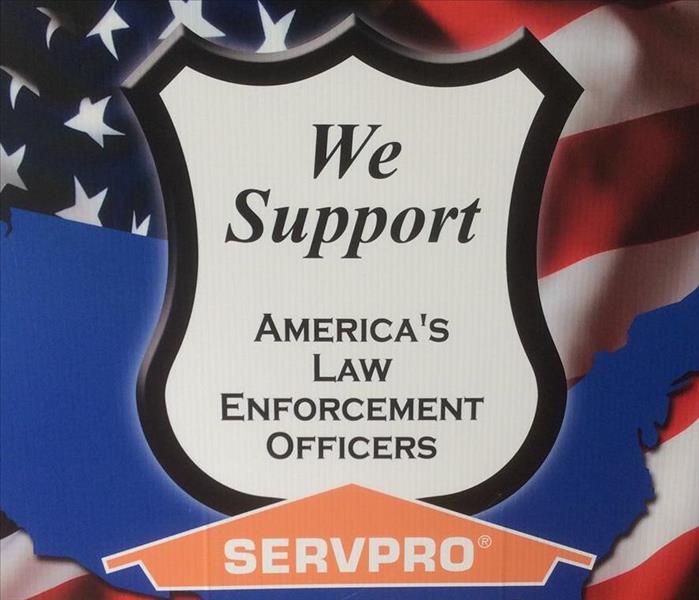 FOP SERVPRO Banner
FOP SERVPRO Banner
SERVPRO was a sponsor of the 44th Biannual Pennsylvania Fraternal Order of Police conference that was held at the Hilton Penn's Landing in Philadelphia. SERVPRO of Society Hill/ Burlington & Mt. Holly and SERVPRO of Upper Bucks were both representing SERVPRO at the conference with a table set up in the exposition hall.
Events for the conference included a welcome party at Sugar House Casino, a celebration at the Michael G. Lutz, Philadelphia Lodge 5 Headquarters on Monday, and our Awards Banquet on Wednesday at the Hilton Hotel.
SERVPRO was supporting the FOP offering refreshments, information about services like bio-hazard cleanup, water damage and mold remediation. SERVPRO supports America's law enforcement officers and it was a pleasure sponsoring the event.
Heading to Philadelphia? Here Are Some Great Museums You Can't Miss!
8/8/2016 (Permalink)
 Philadelphia Pixar Exhibit at The Franklin Institute
Philadelphia Pixar Exhibit at The Franklin Institute
As summer heats up in Philadelphia, the perfect way to stay cool is to check out all of the coolest museum exhibitions that the city has to offer. There are exhibits perfect for kids, teens and adults of all ages!
Here are some of the picks we thought were especially cool:
1. The Franklin Institute: The Science Behind Pixar. We love The Franklin Institute. They are one of our many great customers for emergency and cleaning services but they also have great exhibitions for people of all ages. Learning about the science behind PIXAR animated films is also a great way to spend the hottest part of the day inside and not feel bad about it.
2. The National Constitution Center: Headed to the White House features a great exhibit that is a perfect fit during the 2016 presidential election.
3. Inside Out curated by the Philadelphia Museum of Art: Inside out takes the concept of an art museum to the outside by featuring high-quality replicas of famous art pieces from well-known artists outside in select Philadelphia neighborhoods. Participating neighborhoods include Old City, Brewerytown, and Conshohocken.
4. Cast of Curiosities at the Magic Gardens: One of the houses that stands out the most on South Street in Philadelphia is the Magic Gardens. It's covered in mirrors, tiles and glass art and the artwork inside is abstract and is influenced by the artist's life as a nurse.
There are many more in the great city of Philadelphia that as a member of this community providing water damage restoration we recommend visiting.
SERVPRO of Burlington/ Mt. Holly Completes Crime and Trauma Scene Bio-Recovery Training
8/1/2016 (Permalink)
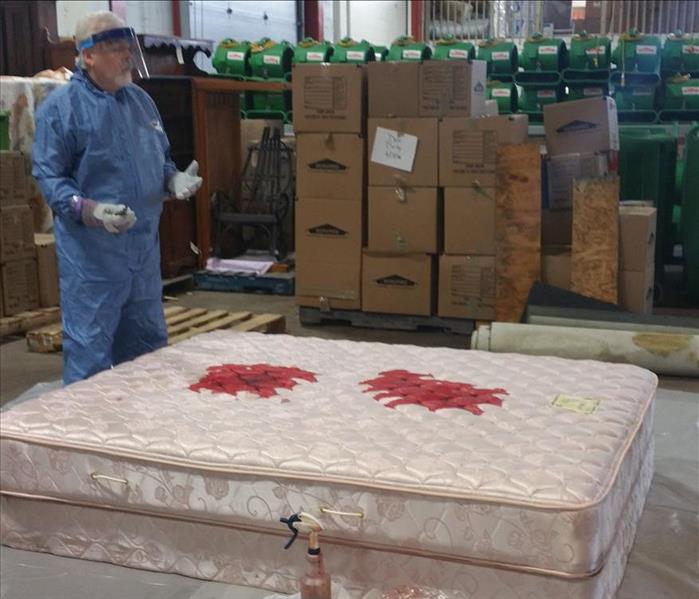 A mock blood mattress used in Bio Recovery Training
A mock blood mattress used in Bio Recovery Training
SERVPRO of Burlington / Mount Holly sent technicians to attend a multi-day training for Bio-Hazard related cleanup. This training course meets and exceeds the requirements of the American Bio Recovery Association (ABRA). Our technicians successfully passed and became certified Bio Recovery Technicians.
The training curriculum extensively covered cleanup of crime scenes, suicide and bodily decompositions. Safe and proper blood-borne pathogen cleanup is a serious business. Clearly a service one hopes they will never require, but should the need arise you can turn to the SERVPRO professionals.
New Jersey's Shore is a Summer Destination For Everyone
7/20/2016 (Permalink)
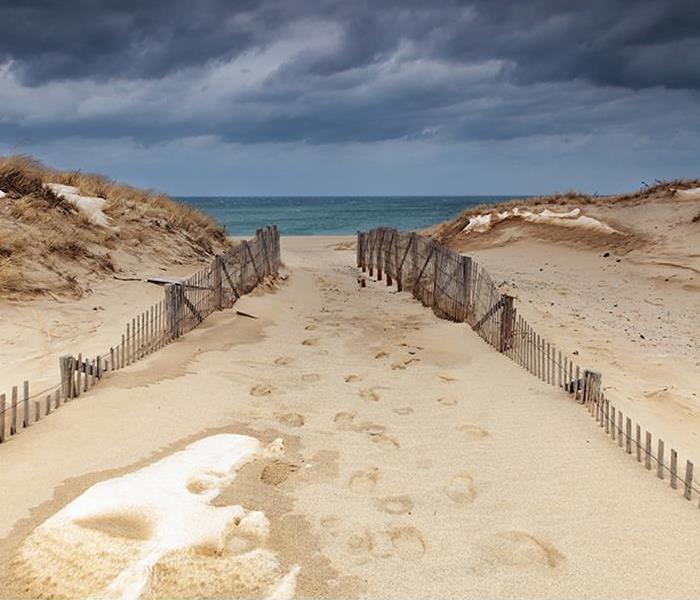 Jersey Shore SERVPRO Water Damage
Jersey Shore SERVPRO Water Damage
New Jersey's crown jewel remains its 130 miles of coastline, spanning from Sandy Hook to Cape May. Our unmatched beaches boast beautiful barrier islands and bays dotted with majestic lighthouses, fishing villages and scenic views.
"Down the Shore" means there's something for everyone. Among New Jersey's most treasured prizes are the white-sand beaches that draw hundreds of thousands of visitors and families each year to enjoy the surf, sand, sun, fun and excitement of the famous Jersey Shore.
- See more at: http://www.visitnj.org/nj/beaches#sthash.XrGW79Sm.dpuf
Mount Holly / Burlington Fourth of July Fireworks on July 3rd
6/29/2016 (Permalink)
 4th of July Fireworks Show in Mount Holly on July 3rd
4th of July Fireworks Show in Mount Holly on July 3rd
Mount Holly Township will be hosting their annual Independence Day Celebration on Sunday, July 3, 2016 from 5 to 11 p.m. The public event will have admission, rides and shows all FREE of Charge. Food and drink available from more than 27 different vendors will be available for purchase. The celebration will be held in Ironworks Park, located at 157 Wollner Drive in Mount Holly and will feature a variety of fun, family-friendly, free activities. Children and adults are invited to enjoy rides, bounce houses, a trackless train, slides, a glow-in-the-dark hula hoop presentation and more. The day will conclude with a spectacular themed fireworks display, which is set to begin promptly at sundown.
SERVPRO Restores More Than Water Damage, Document and Artwork Restoration Services Make Museum Exhibits Possible
6/15/2016 (Permalink)
 Come Fly With Me Document Restoratino Servpro
Come Fly With Me Document Restoratino Servpro
Many Frank Sinatra fans in New Jersey will be able to see an exhibit about the famous singer at the Hoboken Historical Museum between August 2nd and June 30th, 2016.
The exhibit features interactive displays and videos, period-appropriate listening stations, and cherished fan photographs and artifacts to illustrate the singer/actor's formative years in Hoboken, highlights from his remarkable 60-year career, and memories from legions of fans. The exhibit is accompanied by a series of monthly Sinatra singers, plus films and author talks.
SERVPRO offers many document restoration services that could make historical exhibits such as this one possible. With our expert document, painting and artwork restoration services, SERVPRO allows history to be experienced by many people worldwide.
Main Street Mount Holly Preserves History and Provides Family Entertainment
6/8/2016 (Permalink)
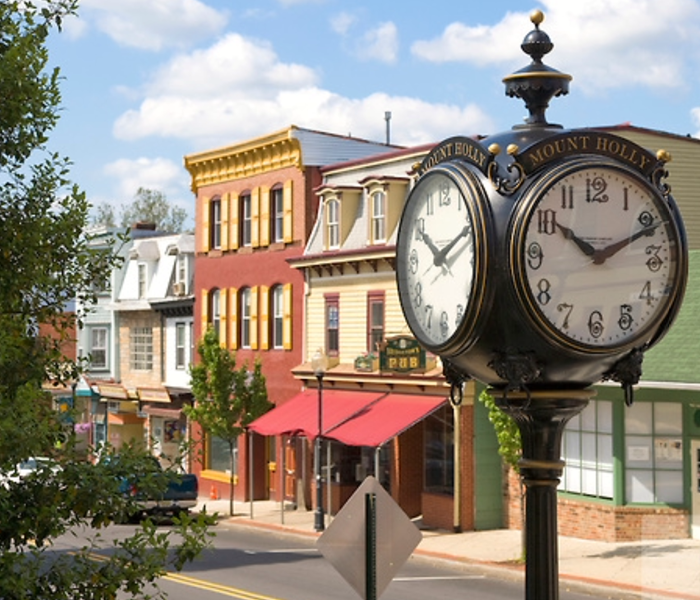 Mount Holly Main Street
Mount Holly Main Street
Mount Holly has tons of New Jersey History dating back to the colonial days and beginnings of our nation.
http://www.mainstreetmountholly.com/ Is a website devoted to events in Main Street of the town, the preservation of it's history and great events that offer family entertainment for all.
Whether you are visiting or live in the area, check it out and enjoy everything there is to offer!
New Rollercoaster Opens in New Jersey
6/1/2016 (Permalink)
 New Rollercoaster at 6 Flags Great Adventure
New Rollercoaster at 6 Flags Great Adventure
This past Memorial Day was filled with excitement all over New Jersey and especially this week at 6 Flags Great Adventure. The park opened a brand new Rollercoaster called The Joker.
Built by S&S Worldwide, this is "4D" Rollercoaster that rotates the passenger cars to different Angels at different points of the Rollercoaster to increase the intensity of drops, turns and loops.
The new Rollercoaster is one of New Jersey's newest great attractions and SERVPRO is proud to be a part of this great community.
Burlington NJ is Home to Over 40 Historic Sites
5/18/2016 (Permalink)
 Burlington New Jersey is home to more than 10 Underground Railroad sites
Burlington New Jersey is home to more than 10 Underground Railroad sites
The city of Burlington, NJ is host to more than 40 historic sites as being the first European settlement in New Jersey. From the Underground Railroad to the country's oldest residence, Burlington is a great location for a weekend trip full of history and culture.
Burlington is home to NJ's oldest firehouse, library and pharmacy. Home to more than 10 Underground Railroad sites, the city offers a self-guided walking tour. The city recommends wearing comfortable walking shoes for the tour which lasts about 2 hours.
SERVPRO enjoys being a member and providing services to this historic community. For more information visit: http://www.tourburlington.org/TourUGRR.html
2016 Mount Holly Townwide Garage Sale This Weekend
5/11/2016 (Permalink)
Spring Cleaning? Left with all kinds of items that are too nice to throw away but you just don't need them anymore?
The town of Mount Holly, New Jersey is offering all residents a free town-wide garage sale on May 14th and 15th 2016!
Visit http://twp.mountholly.nj.us/ to find a list of every resident who signed up and see what hidden treasures you can find!
SERVPRO Communities: Weather Forecasting in Mount Holly
5/5/2016 (Permalink)
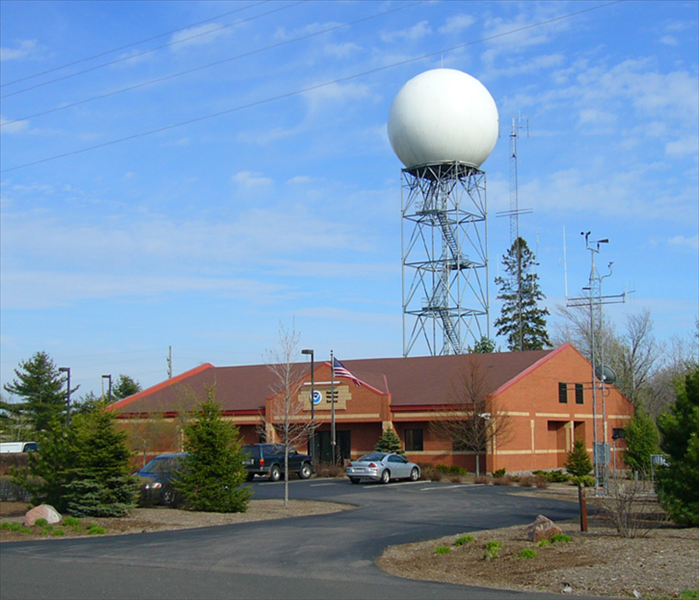 A Weather Forecast Office
A Weather Forecast Office
The great cities of Burlington and Mount Holly, New Jersey are both cities with impressive historical backgrounds in areas such as religious freedom and civil rights but also are home to the National Weather Services’ Forecast Office for the tristate area.
Weather is monitored around the clock here generating forecasts and issuing alerts for severe weather. Modern equipment such as satellite data and advanced radar systems are the tools used to help keep the public informed and safe.
SERVPRO of Burlington / Mount Holly professionals are also ready to help 24/7 in the event that severe weather damages your home and we are proud to be a member of this rich and vibrant community.
Celebrate Summer Safely
7/15/2014 (Permalink)
With summer in full swing with barbecues every weekend and camping trips set, SERVPRO of Burlington Mt Holly wanted to share a few safety methods to keep your barbecues fire free and trips enjoyable:
When using charcoal, don’t forget to use the proper starter fluids
Gas Grills – check to make sure the hose connections are property hooked up and tightened
When starting a camp fire, remember to build the fire downwind, and remember to make sure the fire is smothered before going to sleep!
SERVPRO of Burlington Mt Holly wishes you all a happy and safe summer!
Happy Holidays
12/23/2013 (Permalink)
Happy Holidays to your family from ours! Have a safe and happy New Year! We are open 24/7, 365 days/year. If you need us, please feel comfortable calling us over the holiday season.
Warm Wishes,
SERVPRO of Burlington/Mt Holly
Holiday Safety Tips
12/2/2013 (Permalink)
Each year in the United States, 21 million doctor visits and 20,000 deaths are chalked up to home accidents. The leading cause of home accidents is falls, followed by poisoning, fire, choking, and drowning. This month's blog will address the #3 cause of death, fire, but it should be noted that all of these types of accidents are preventable. In any case, I will give you some information on holiday hazards and how to prevent disaster.
December is the peak time of year for home candle fires and electrical fires. In fact, candle fires are four times more likely to occur during winter holidays. So how do you prevent candle fires? Well, the most obvious way is not to burn candles, instead opting for the flameless variety. But, if you are like me, that is not an option. I like candles too much not to burn them, so instead I follow some simple safety rules:
1) Only burn candles in approved candleholders, on stable surfaces.
2) Keep the candles 12" from anything flammable.
3) Burn candles in a well-ventilated area. To avoid black soot on surfaces, choose candles with a 100% cotton wick.
4) Blow out candles when leaving a room or when going to bed. I use a candlesnuffer to minimize smoke and loose embers.
5) Keep candles away from little fingers and wagging tails!
Definitely keep candles away from Christmas trees! A heat source too close to the tree causes one in six Christmas tree fires. When purchasing your Christmas tree, consider a flame-retardant artificial tree. If this is not an option, perform a "Freshness Test" on an evergreen: give it a little shake. If a lot of needles fall off, the tree is not freshly cut. Also, bend the needles between your fingers. They should not break. Once you've determined that your tree is safe and you bring it home, place it at least 3 feet away from fireplaces, space heaters, or central heating systems (the same goes for your wreaths and pine cones!). Do not block exits with your tree. And make sure your tree has plenty of water every day. When decorating your tree, try to choose non-combustible and flame-resistant materials, and plastic tinsel.
According to the U.S. Consumer Product Safety Commission, 12,500 people end up in the emergency room with decorating-related injuries each year. Of these, 5,000 are from electrical shocks or burns. There are some simple tips you can rely on to minimize your chances of serious injury from your holiday lights! For starters, LED lights are safer. If you are buying new lights this year, consider LEDs. They do not produce the same amount of heat as traditional lights. Always, always, always look for the safety tag on holiday lights. This usually reads "UL" for "Underwriters Laboratories," but may also read "ELT" or "CSA". (It is important to note that when you are buying electrical toys, the same safety tag should be present!)
Before hanging your lights, check for fraying wires. When replacing bulbs, unplug the light string first, and be sure to match voltage and wattage of the original bulb. Do not overload your electrical outlets or create chains. And never use electric lights on a metallic tree. If the wire is faulty, it can cause a shock to whoever touches the tree!
When hanging outdoor lights, start with proper ladder safety. Keep electrical connectors off the ground and away from metal rain gutters. Use insulated tape or plastic clips to hold the light string in place. Use an outdoor timer certified by CSA International. And always turn off the lights when you leave the house or go to bed.
Last, but certainly not least, I have some fireplace safety tips for you this holiday season. Some people use their fireplaces for warmth, while others use it for ambience, but everyone should use them safely. Do not use your gas fireplace if the glass panel is removed, cracked or broken, and only allow a qualified person to replace parts. According to the American Red Cross, 36% of people with fireplaces report they never cleaned or inspected their chimneys! It is recommended that you hire a chimney sweep once per year to clean and inspect your chimney. You can find a certified one at http://www.csia.org. It is a good idea to have your chimney capped as well to avoid birds and squirrels becoming trapped inside.
Before starting a fire, check to see that the flue is open. Choose dense wood, such as oak, that has been split and stored in a high and dry place for at least 6 months. Do not overload your fireplace, and do not burn wrapping papers. Place logs at the rear of the fireplace on a metal grate, and use kindling to start the fire. Always use a spark guard.
While there is no guarantee that you WON'T experience a home fire this holiday season, if you follow these tips, you will be less likely to suffer fire damage. Nevertheless, accidents happen. If an accident affects you, or someone you know, please call us. We are available 24/7 and 365 days each year. Once the fire damage mitigation begins, SERVPRO of Burlington/Mt Holly will keep you informed and answer your questions, all while working to help make the fire damage “Like it never even happened.” Everyone here at SERVPRO wishes you and your family a safe and happy holiday season!
Carbon Monoxide Poisoning Prevention
10/16/2013 (Permalink)
I recently had a conversation with a client about Carbon Monoxide dangers. I gave her our SERVPRO monthly newsletter with an article called "Carbon Monoxide: The Silent Killer" and we discussed how many of the tips we did not know. So I decided to do a little research and find out what else I did not know about carbon monoxide (CO) to share with all of you.
Let me start by telling you that I have had CO poisoning previously, and it is not fun. I was working at another company, and I was outside in a tent all day. It was November and it was cold. While the tent had "walls", they were rolled up most of the day to allow people to freely come in and out. We had two large portable kerosene heaters to make the space a little more comfortable. My fingers were numb while I was trying to type and my teeth were chattering (I am always cold anyway, so this was torture!) I moved the heaters closer to my desk and pointed them both straight at me.
I am not sure how much time passed, but I remember feeling dizzy and light-headed. I stood up and told my manager that I felt sick. I was nauseated and I could feel a headache coming on. It was not unlike a bad sinus headache. I did not know enough about CO to realize that was causing my symptoms. CO poisoning can be difficult to diagnose because the symptoms often mimic other illnesses. Anyway, it took my manager and another co-worker to help me outside. In just a matter of minutes, I could not walk or talk. They helped me to a car far from the tent and told me to rest inside with the heat on. That is the last I remember. I woke up hours later with an enormous bump on my forehead. We guessed that I passed out inside the car and banged my head on the dashboard. It was a terrifying experience.
Later, I discussed it with my doctor, and he told me that it was probably CO poisoning. My co-workers were right to remove me from the tent and get me fresh air, but they probably should have taken me to the emergency room. I had a bad headache the day after the incident, but otherwise I was okay. If I was not a healthy adult, the outcome may have been very different. I was fortunate.
But here's where you can benefit from my bad experience: don't make these mistakes! Just because you are outside or the windows are open or the garage door is lifted, does not mean you are safe. Please heed the following information to protect you and your family from this silent killer!
You can't see or smell carbon monoxide, but at high levels, it can kill a person in minutes. Often called the silent killer, carbon monoxide, or CO, is an invisible, odorless, colorless gas created when fuels, like gasoline, wood, coal, natural gas, and propane burn incompletely.
According to the Environmental Protection Agency, each year, more than 500 Americans die from unintentional CO poisoning. It is estimated that another 20,000 visit the emergency room. All people and animals are at risk for CO poisoning, with some groups including unborn babies, infants, and people with chronic heart disease, anemia, or respiratory problems, are more susceptible to its effects. The most common symptoms of CO poisoning are headache, dizziness, weakness, nausea, vomiting, chest pain, and confusion.
Protect yourself by reviewing the following tips, provided by the United States Fire Administration and the Centers for Disease Control and Prevention.
?Have fuel-burning appliances, like oil and gas furnaces, gas or kerosene heaters, fireplaces and wood stoves, inspected by a trained professional every year. If you smell an odor from your gas refrigerator's cooling unit have an expert service it.
* When purchasing gas equipment, buy only equipment carrying the seal of a national testing agency, such as the American Gas Association or Underwriters' Laboratories.
* Open the damper for proper ventilation before using a fireplace. Have your chimney checked or cleaned every year. Chimneys can be blocked by snow and other debris. So can dryer vents!
* Never use your own stovetop to heat your home. Never burn anything in a stove or fireplace that isn't vented. All gas appliances must be vented. Make sure all fuel-burning vented equipment is vented to the outside. Keep the venting for exhaust clear and unblocked. Never patch a vent pipe with tape or gum. Horizontal vent pipes to fuel appliances should not be perfectly level. Indoor vent pipes should go up slightly as they go toward outdoors. This helps prevent CO or other gases from leaking if the joints or pipes aren't fitted tightly.
* If you need to warm a vehicle, remove it from the garage immediately after starting it. Never run a vehicle or other fueled engine or motor indoors, even if garage doors are open! Make sure the exhaust pipe of a running vehicle is not blocked with snow, ice or other materials. Have a mechanic check the exhaust system of your car every year.
* If you drive a vehicle with a tailgate (like an SUV), when you open the tailgate, you also need to open vents or windows to make sure air is moving through your car. If only the tailgate is open, CO from the exhaust will be pulled into the car.
* Only use barbecue grills outside, away from all doors, windows, vents and other building openings. Some grills can produce CO gas. Never use grills inside the home or the garage, even if the doors are open. Never burn charcoal indoors. Burning charcoal - red, gray, black or white- gives off CO.
* Use portable generators outdoors in well-ventilated areas away from all doors, windows, vents and other building openings to prevent exhaust fumes from entering the home.
* Probably the most important thing you can do is to install carbon monoxide detectors in your home, particularly in your bedroom. People who are sleeping or intoxicated can die from CO poisoning before ever experiencing symptoms. Place the detector 5 feet above the floor and away from fireplaces or furnaces.
Hurricane Season Wrap-up
10/2/2013 (Permalink)
 Image courtesy of cooldesign at FreeDigitalPhotos.net
Image courtesy of cooldesign at FreeDigitalPhotos.net
I recently learned about how the Saharan Air Layer was present and very intense this year, thus effecting the development of tropical storms on our side of the Atlantic, (the SAL extended 3,000 miles over the Atlantic, from the Western coast of Africa, almost to Puerto Rico). From what I can gather, this was true for the first half of Hurricane Season, resulting in a quiet summer. As most of you have probably heard, a Hurricane did develop this year, but it did not affect any land masses. As I write this final installment in my Hurricane series, most of my friends and family are feeling confident that we will not experience another catastrophic storm in 2013. While I am hoping for the best outcome, it is always necessary to be prepared for the worst situation. Lest we forget, Superstorm Sandy roared onshore at the end of October last year. So, just in case, I would like to review with you what to do after the storm: how to handle insurance, how to manage your emotional health, and how to help your community--or any community--affected by disasters.
How to Handle Insurance
Nationwide Insurance has the following tips for handling the aftermath of damage from an incident like a major storm. Note that these tips are general in nature and not specific to Nationwide policies or Nationwide's claims processes. Always refer to your insurance policy and company for specific procedures if you may have a potential claim.
- Call your insurance company. After you file a police or fire report (if required) , contact your insurance agent or company’s claims department. Your policy will likely require you to do so within a certain amount of time after the loss. When you call, have all of the details of the incident, plus your policy number.
- Complete a claims form with your agent. This form includes all the details of the incident. Be thorough – note what was damaged, when and how. For smaller claims, filing a claims report should suffice. For larger losses, your agent may send an adjuster to inspect the damage.
- Document the damages. Before you begin cleanup, photograph or record the damage and include the images with your claim. It’s a good idea to visually document your home and belongings before a loss, so you have “before” and “after” images when filing a claim.
- Make temporary repairs so your home is safe and livable. While you’re waiting for your claim to be processed, you may make temporary repairs. But review your policy for guidelines about what’s covered and be sure to save your repair receipts. Don’t start permanent, major repairs or renovations until your claim is complete and your compensation is confirmed.
- If you have to move temporarily, save your receipts. If the damage to your residence is so extensive that you must relocate for a while, your policy may help cover those costs. Save hotel and restaurant receipts – and discuss with your agent how to submit them for reimbursement.
- Make yourself available. Be reachable and ready to talk with your insurance agent and claims adjuster after you file a claim. The faster you can answer questions and provide necessary information, the faster your claim may be able to be processed.
Details vary by state and policy language. Please consult your policy for the specifics of your selected coverages. Subject to underwriting guidelines, review, and approval.
How to Manage your Emotional Health
After Hurricane Katrina, I was a mess. That's the simplest way to put it. I had evacuated, and it would be six weeks until I knew whether any of my personal belongings were undamaged. I didn't know if I had a home to go back to, or where to go after I left the Ramada Inn in Northeast Texas, or if my boss and his family (who chose to ride out the storm) were alive, or how I would survive without a job or unemployment eligibility. I had packed clothes for 3 days, all of my photo albums and valuable jewelry, my pets, and my personal documents. Knowing that was all I had, and not knowing how long I would have to wait to know more was one of the most stressful times in my life. The not knowing was the source of major anxiety for me and my family.
Here is some information on how to recognize and deal with your current feelings, courtesy of the American Red Cross. When we experience a disaster or other stressful life event, there are a variety of common reactions including:
Feeling physically and mentally drained.
Having difficulty making decisions or staying focused on topics.
Becoming easily frustrated on a frequent basis.
Frustration occurring more quickly and more often.
Arguing more with family and friends. J Feeling tired, sad, numb, lonely or
worried.
Experiencing changes in appetite or sleep patterns.
Most of these reactions are temporary and will go away over time. Try to accept whatever reactions you may have. Look for ways to take one step at a time and focus on taking care of your disaster- related needs and those of your family.
Taking action. Getting ourselves and our lives back in a routine that is comfortable for us takes time.
Take care of your safety. Find a safe place to stay and make sure your physical health needs and those of your family are addressed. Seek medical attention, if necessary.
Eat healthy. During times of stress, it is important that you maintain a balanced diet and drink plenty of water.
Get some rest. With so much to do, it may be difficult to have enough time to rest or get adequate sleep. Giving your body and mind a break can boost your ability to cope with the stress you may be experiencing.
Stay connected with family and friends. Giving and getting support is one of the most important things you can do.
Be patient with yourself and with those around you. Recognize that everyone is stressed and may need some time to put their feelings and thoughts in order.
Set priorities. Tackle tasks in small steps.
Gather information about assistance and resources that will help you and your family members meet your disaster-related needs.
Stay positive. Remind yourself of how you’ve successfully gotten through difficult times in the past. Reach out when you need support, and help others when they need it.
If you still don’t feel better ...
Many people have experience coping with stressful life events and typically feel better after a few days. Others find that their stress does not go away as quickly as they would like and it influences their relationships with their family, friends and others.
If you find yourself or a loved one experiencing some of the feelings and reactions listed below for 2 weeks or longer, this may be a sign that you need to reach out for additional assistance.
Crying spells or bursts of anger
Difficulty eating
Difficulty sleeping
Losing interest in things
Increased physical symptoms such as headaches or stomachaches
Fatigue
Feeling guilty, helpless or hopeless
Avoiding family and friends
For additional resources, contact your local Red Cross Disaster Mental Health or community mental health professional.
Please seek immediate help if you or someone you know is feeling that life isn’t worth living or if you are having thoughts of harming yourself or others. You can also contact the National Suicide Prevention Lifeline at 1-800-273-TALK (8255)
Let Your Family Know You’re Safe
If your community experiences a disaster, register on the American Red Cross Safe and Well Web site available through RedCross.org to let your family and friends know about your welfare. If you don’t have Internet access, call 1-866-GET-INFO to register yourself and your family.
How to Help your Community
According to FEMA, In the face of disaster, Americans come together with courage, compassion and unity and ask, “How can I help?” There are many ways to get involved especially before a disaster occurs. You can find some of these ways at: http://www.ready.gov/get-involved. For ways you can get involved after the disaster happens, reach out to your local faith-based and community organizations. You can also support major disasters by donating cash or goods which may help meet the needs of your community. After Hurricane Katrina, I found the most help from family and friends donating clothes, books to pass the time, and gift cards. Don't forget underwear and socks when purchasing new items to donate!
The Red Cross also offers programs for before and after the disaster to help your community. You can find some of these options at: http://www.redcross.org/support/get-involved. I also found support in the people who would listen to me tell my story, without passing judgment on my actions or on the actions of the politicians involved. That kind of negativity would only increase my anxiety, as opposed to diminishing my fears. Through Citizen Corps, individuals can learn about opportunities to get involved and help build capacity for first responders. With proper training and education, civilian volunteers expand the resources available to states and local communities. Many partner organizations offer public education, outreach and training for free. Learn how to get involved through Citizen Corps at http://www.ready.gov/volunteer.
Thank you for following my Hurricane blog for the last few months. I hope you learned something useful! This will be the last month for Hurricane-related blogging (unless, of course, we have a major hurricane effecting our area) until next year. If there is a topic you are interested in learning more about this winter, please email me with your suggestions: aflynn@servprosocietyhill.com.
The Peak of Hurricane Season!
8/23/2013 (Permalink)
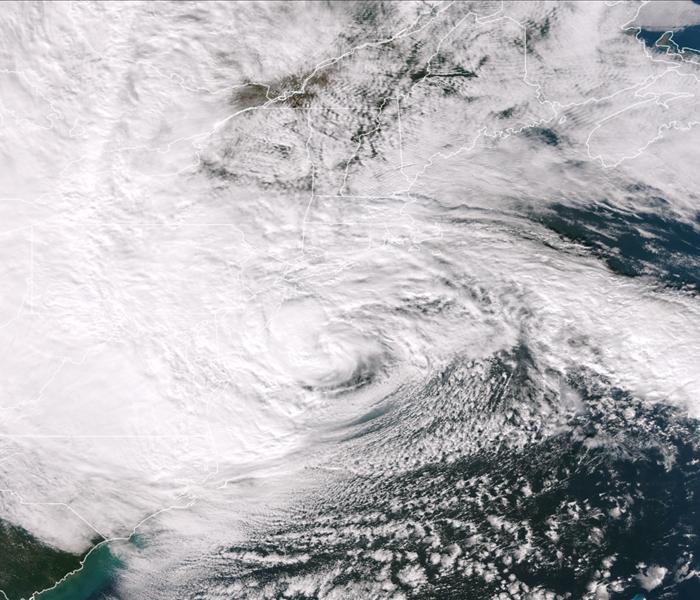 Hurricane Sandy Approaching the East Coast, October 29, 2012 (photo courtesy of NASA/NOAA)
Hurricane Sandy Approaching the East Coast, October 29, 2012 (photo courtesy of NASA/NOAA)
In the past few weeks, people in my community have been asking me if we are really busy at SERVPRO because Hurricane Season is starting. If you have been following this blog, you know that Hurricane Season started months ago! Many disastrous hurricanes have occurred in the fall months in recent years, but that's not always the case. Hurricane Charley struck southwest Florida in early August of 2004 as a Category 4. Hurricane Agnes affected Florida and New York City in June of 1972 and caused billions of dollars in damage and 390 deaths as a category 1 storm. Hurricane Audrey (1957), the only Category 4 June hurricane on record in the Atlantic Basin, hit along the Texas and Louisiana border, claiming at least 416 lives in the U.S., the 7th deadliest U.S. tropical cyclone on record. Only Hurricane Katrina (2005) claimed more lives since Audrey. Nevertheless, the top 10 most devastating hurricanes (measured by strength) have affected the United States in August and September. This month, we will discuss what the different categories of Hurricanes mean to you. We will also review your power outage checklist, and what to do during the storm.
The Saffir-Simpson Hurricane Scale was developed in the early 1970s by Herbert Saffir, a consulting engineer in Coral Gables, Florida, and Dr. Robert Simpson, then director of the National Hurricane Center. The 1-5 category scale used to give an estimate of the potential property damage and flooding expected along the coast from a hurricane landfall.
- Category 1: Minimal Damage (which is really not accurate, if you see the example of Hurricane Agnes above!) Winds are 74-95 mph, sustained. (Wind gusts may be stronger.) You may have damage to your roof, vinyl siding, and gutters. Tree branches are likely to snap, and power outages are common. Coastal road flooding is possible.
- Category 2: Moderate Damage. Winds are 96-110 mph sustained. Shallowly rooted trees will be uprooted and block roads. Well-constructed homes could sustain major roof and siding damage; major damage to exposed mobile homes. Coastal roads and low-lying escape routes inland can be cut off by rising water, about 2-4 hours before landfall. Considerable damage to piers and marinas is likely. Near-total power loss should be expected.
- Category 3: Extensive Damage. Considered a Major Hurricane. Winds are 111-129 mph, sustained. Mobile homes will be destroyed, and well-constructed homes will incur major damage and potentially structural damage. Serious flooding, especially on flat terrain 5 feet or less above sea level (up to 8 or more miles inland). Expect loss of electricity and water for several days or several weeks. Hurricane Katrina was a Category 3 storm. It was the second most intense storm to hit the US, the most costly hurricane (twice as expensive as Hurricane Sandy) and the third deadliest. Category 3 storms are no joke!
- Category 4: Extreme Damage. Considered a Major Hurricane. Sustained winds are 130-156 mph. Mobile homes will be demolished. Complete failure of roofs on smaller homes. Well-built frame homes will likely have damage to the roof and exterior walls. Flat terrain 10 feet or less above sea level will be flooded inland as far as 6 miles. Major erosion of beaches. Massive evacuations required. Power outages will last weeks to possibly months. Most of the area will be uninhabitable for weeks or months. Hurricane Andrew was a Category 4 when it hit Florida in August of 1992.
- Category 5: Catastrophic Damage. Considered a Major Hurricane. Sustained winds of 157 mph or greater. (For those of you who are familiar with tornadoes, a Category 5 Hurricane would be the equivalent of an F3 or greater tornado, which represents about 5% of all tornadoes. The reason you cannot compare the intensity of the two is because tornadoes generally last for minutes over one area, while hurricanes can last for days.) A high percentage of framed homes and industrial buildings will be destroyed, with total roof failure and wall collapse. Major damage to lower floors of all structures less than 15 feet above sea level within 1500 feet of shore. Massive evacuations as far inland as 10 miles may be required. Hurricane Camille, a Category 5, was the second most intense Hurricane ever to hit the US, in August of 1969. The final wind speed will never be known because all measuring devices were destroyed, but it is thought to exceed 200 mph.
So what does all this mean for you? You only need to know 2 things: Prepare, and Heed all evacuation orders. According to the Corporation for National and Community Service, "Research on preparedness shows that people who believe themselves “prepared” for disasters often aren’t as prepared as they think. Forty percent of survey respondents did not have household plans, 80 percent had not conducted home evacuation drills, and nearly 60 percent did not know their community’s evacuation routes." Stay safe and stay alive.
Safety During the Storm
What are some tips for staying safe during the storm? First of all, you need to know what to do based on the type of storm that you are facing. You can find this information at: Red Paw Emergency Relief Team. The following list is for a summer storm:
* Use your battery-operated NOAA Weather Radio for updates from local officials. I would not recommend relying on an app on your cell phone as you will wear the battery down. If you lose power, you will be unable to recharge your phone if you really need it. So invest in a battery-operated NOAA radio (about $35) and turn your cell phone off, or on to airplane mode to conserve the battery.
* Avoid contact with corded phones. Cordless phones are safe to use. Cellular phones are also safe but see above for info about the battery! Or, purchase an alternative charging device for your cell phone so you always have power. Kent German has some unique suggestions at Cell phone chargers - CNET Reviews.
* Avoid contact with electrical equipment or cords.
* Unplug appliances and other electrical items, such as computers. Power surges from lightning can cause serious damage. (Are we seeing a pattern here?)
* Avoid contact with plumbing. Plumbing and bathroom fixtures can conduct electricity.
* Stay away from windows and doors.
Power Outage Checklist
If a power outage is 2 hours or less, you need not be concerned about losing your perishable foods. For prolonged power outages, though, there are steps you can take to minimize food loss and to keep all members of your household as comfortable as possible, according to The American Red Cross. For their complete list, click here.
Keep your refrigerator and freezer doors closed as much as possible. Use perishable food from the fridge first. An unopened refrigerator will keep foods cold for about 4 hours. Then use food from the freezer. A full freezer will keep the temperature for about 48 hours (24 hours if it is half full) if the door remains closed. When the power comes back on, throw away any food that has been exposed to temperatures of 40 degrees or higher for 2 hours or more. When in doubt, throw it out!
Turn off and unplug any unnecessary electrical equipment. Leave one light turned on so you will know when the power comes back on. If purchasing a generator, consult an electrician to make sure you get the right one. Never use a generator inside, or in a partially enclosed area. Install carbon monoxide alarms in central locations on every level of your home. If the alarm sounds, move quickly to a fresh air location outdoors or by an open window or door and call for help. Carbon Monoxide kills.
If your community experiences a disaster, register on the American Red Cross Safe and Well Web site available through RedCross.org to let your family and friends know about your welfare. If you don’t have Internet access, call 1-866-GET-INFO to register yourself and your family.
As I write this blog, the Atlantic/Gulf/Caribbean is unusually quiet. That worries me more than if it had been busy all season. People tend to think the danger has passed, or is not imminent. But now is the perfect time to start making your disaster kit (if you haven't already!) as most items will be on sale. For more money-saving tips, see our June Blog, "Storm Preparedness." Next month will be our last blog of this storm series. Hopefully, the Atlantic will still be quiet. Have a safe and happy Labor Day Weekend.
Family Emergency Preparedness
7/31/2013 (Permalink)
 Bowzer, just one example of a very important family member!
Bowzer, just one example of a very important family member!
So far, in our Emergency Preparedness series, we have learned about the naming of Hurricanes, Hurricane Shutters, preparing your family and business emergency plan, and how to get prepared on a budget. This edition, we will be focusing on what to include in your Emergency Supply Kit, what to do BEFORE an approaching storm, and how to keep your pets safe in a disaster.
Before the Storm
Before the storm, it is important to build an emergency supply kit and develop your emergency plan. Please see our blog from June for more information on your written plan, and see the next section for information about your Emergency Supply Kit. But what else can you do to prepare yourself, your family, your home and/or business, and your pets for a disaster?
Learn how to shut off utilities:
1) Contact your local gas company in advance to determine what your home requires, and the exact procedure for shutting off the gas. It might even be a good idea to post instructions somewhere near the meter. If at any point, though, you smell gas or hear a hissing noise, FEMA advises that you open a window and get everyone out of the house. Contact your gas company immediately.
2) Locating the main shutoff valve for your water supply in advance of a disaster is important. If you have trouble, contact a local plumber or your area water utility for assistance. Once you’ve identified the main water shutoff valve, make sure everyone in the household knows where it is, and how to turn it off. To prevent any possible confusion, consider labeling the water valve with a colored identification tab. SERVPRO can also provide you with shutoff valve tags.
3) Electrical sparks can ignite leaking natural gas, resulting in an explosion, says FEMA. Which is why, following a natural disaster, the electricity may need to be shut off immediately. If your home has a basement, the electrical circuit box is likely located there, but that’s not always the case. Be sure that everyone in your home knows where the circuit box is, well in advance of an emergency. (Tips provided by Allstate)
Some other steps you can take as the storm approaches:
- Unplug any electronic equipment.
- Unplug any electronic equipment.
- Secure outdoor objects that could blow away or cause damage.
- If you are outdoors, get inside a building, home or hard top vehicle (not a convertible).
- Shutter windows and secure outside doors.
- Follow SERVPRO of Burlington/Mt Holly on Twitter and Facebook for additional tips.
For information on how to prepare for specific types of disasters, visit our friends' website: Red Paw Emergency Relief Team Emergency Preparedness.
Emergency Supply Kit
There are many lists out there of what you could or should put in your emergency kit, or go bag. You can even purchase pre-packed kits for the quick solution. But you will find you have most of the basic items in your home already, and it will just take a few hours to put it altogether. The items we suggest as necessary for every kit are:
- Water (one gallon per person per day; this includes pets!)
- Food (non-perishable 3-day supply)
- Manual can opener
- Battery operated radio, preferably a NOAA Weather Radio
- Flashlight and extra batteries
- First aid kit
- Whistle to signal for help
- Clothing
- Dust masks or bandana
- Plastic sheeting, garbage bags, and duct tape
- Wrench or pliers to turn off utilities
- Hygiene items
- Important documents: copies of insurance policies, identification, and bank account information
- Cash
- Fire extinguisher
- Matches in a waterproof container
- Prescription medication for people and pets
- For pets: Food; leash, harness or carrier; records of vaccinations; non-tippable food and water containers, a picture of your pet, and a favorite toy of your pet's.
For specific examples, please visit The Weather Channel.
Pets
Not everyone has them, but those that do know that your pets are just as important as your other family members, and should not be forgotten about in case of an emergency. After Hurricane Katrina, it became obvious that many people who do not heed evacuation orders are responding to the fact that they don't know what to do with their pets. As a result, many shelters are now pet-friendly. Just like with everything else, a little planning can help keep your pets safe in the time of a disaster.
Often, warnings are issued hours, even days, in advance. At the first hint of disaster, act to protect your pet. Know which hotels and motels along your evacuation route will accept you and your pets in an emergency. Call ahead for reservations if you know you may need to evacuate. Ask if no-pet policies could be waived in an emergency. Talk to friends and family members about taking your pets, but make sure your pet is comfortable with that person and that person is comfortable with your pet. If you are not home and cannot get home following a disaster, make sure you have pre-arranged with someone in your neighborhood to check on your animals.
Ensure that all pets are wearing collars with securely fastened, up-to-date identification. Consider microchipping your animals. Bring pets inside so you won't have to search for them if you need to leave quickly. NEVER leave your pets behind! There is simply no reason to anymore, unless you do not heed evacuation orders and they come to rescue you by boat--then, and only then, is it difficult to bring your pet along. ALWAYS evacuate when told to do so and bring ALL family members with you.
If you must evacuate, there are some additional travel tips that Progressive Insurance recommends:
- Prepare a doggie bag with food and water for travel. Depending on where you live, evacuation routes can be congested with traffic and you may be in the car much longer than you intended.
- Bring your pet's favorite toys, and a doggie first aid kit as well. Pets can experience anxiety just like the human members of your family.
- Secure your pet in your vehicle within a travel crate or with a harness.
- Never leave your pet unsupervised in the car.
- Make sure your pet is covered on your car insurance policy. Progressive is the first major car insurance company to provide Pet Injury Coverage, at no additional charge, to cover your pet's vet bills in the event of an accident.
Next month, I will provide you with information on what the different categories of hurricanes mean to you, what to do during a storm, and we will review your power outage checklist. In September, we will consider some expert tips on how to manage your emotional health after a disaster, and ways to help your community or other communities effected by severe weather. As always, follow us on social media for additional information on preparedness, and sign up for our monthly newsletter with quizzes and contests based on this blog!
Storm Preparedness
6/26/2013 (Permalink)
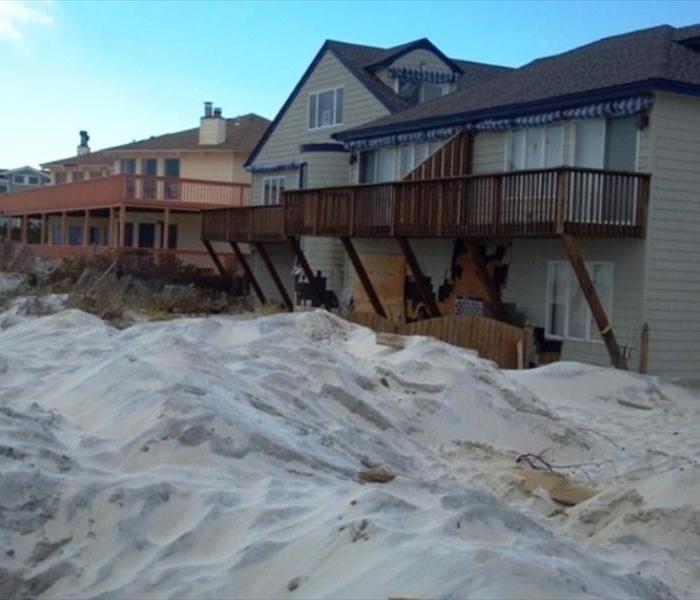 These houses on Long Beach Island, NJ were effected by Hurricane Sandy in October 2012.
These houses on Long Beach Island, NJ were effected by Hurricane Sandy in October 2012.
With two named storms so far this Hurricane Season, it is important to continue to stay vigilant in our severe weather preparations. This month, I will provide you with information on how to prepare before the storm is even named and how to prepare on a budget.
Are you at risk for a direct hit? Check out this Map to see if your state has a history of hurricane activity. If you are here in New Jersey, I can assure you that you are at risk! Next, take our quiz to determine your level of preparedness:
WHAT ARE YOU DOING TO PREPARE?
Are you prepared for an emergency? Quiz yourself on the questions below to see just how prepared you are. If you don’t know the answer to some of the questions, visit Ready.gov or your local Office of Emergency Management for tips and resources that can help make sure you, your family, and your community are Ready.
- Does your local government have an emergency or disaster plan for your community? If so, do you know what it is?
- Do you know how to find the emergency broadcasting channel on the radio?
- Does your city/county have an emergency alert system? Is so, are you signed up to get alerts?
- Do you know your local evacuation routes? How would you get out of town from work? How about from home?
- Does your city/county have a Citizen Corps Council? (If you don’t know, visit http://www.ready.gov/citizen-corps)
- In the last year, have you prepared or updated your Emergency Supply Kit with emergency supplies like water, food and medicine that is kept in a designated place in your home?
- In the last year, have you prepared a small kit with emergency supplies that you keep at home, in your car or where you work to take with you if you had to leave quickly?
- In the last year, have you made a specific plan for how you and your family would communicate in an emergency situation if you were separated?
- Are you prepared to help your neighbor? In most emergencies, the best way to get help quickly is by working with your neighbors. Do you know anyone in your neighborhood who might need a little extra help preparing for or responding to an emergency?
- Have you established a specific meeting place for your family to reunite in the event you and your family cannot return home or are evacuated?
- In the last year, have you practiced or drilled on what to do in an emergency at home?
- In the last year, have you volunteered to help prepare for or respond to a major emergency?
- Have you taken first aid training such as CPR in the past five years?
If you are like me, you probably don't have the answers to most of the questions in our quiz. Now is the time to seek out those answers. There is no impending doom coming towards our area as I write this, so it is our nature to assume none is coming. I like to hope for the best, but prepare for the worst. With a little thoughtful planning now, we can be ready for whatever comes our way all summer long.
Let's talk about an emergency preparedness plan for your home and business first. If you do not have one in place for your business, contact us right away. We can provide you with a no-cost assessment of your facility and compile all the data in our SERVPRO Ready Plan app for your smartphone. For your home, we recommend creating a written emergency preparedness and action plan NOW. Start by deciding where to go if you are at home, school, work, outdoors, or in a car when a hurricane or tropical storm threatens. Update these plans every school year and as places of employment and residence change. Identify two places where you and your family members can meet if you are separated: one outside your home and another outside your neighborhood. Learn how your local government handles emergencies by contacting your local American Red Cross chapter or local Emergency Management Agency (EMA). Review your insurance coverage for your home and business. Find out if you live in a hurricane evacuation zone by contacting your local emergency management office. Visit The Weather Channel for more information.
To physically prepare your home and business for a future storm, consider purchasing hurricane shutters now. If you do not live on the coast, but still want to protect your windows from high winds, plywood is a good option. Purchase it now to avoid scarcity immediately before the storm. It is recommended that you the lumber you use to cover your windows be a minimum of 3/4" thick, but preferably 1" thick. You can purchase (2) 1/2" thick boards and double up. This thickness will hold up well in most hurricane conditions up to a Category 3. The Insurance Institute of Business and Home Safety provides further information on how to prepare your home, what to consider when remodeling, and tips on how to prevent water damage.
PREPAREDNESS ON A BUDGET
It Doesn’t Cost a lot to be Prepared
It is no secret that many families and individuals are looking to cut back on spending. But with the frequency of disasters, both natural and manmade, can you afford not to be prepared? Preparedness doesn’t have to cost an arm and a leg. Here are a few tips* on how you can protect those that matter to you without spending a fortune.
- Make a Plan. Work with you family and neighbors to make an emergency plan for the types of disasters that affect your area. Make sure everyone in your family understands where to go and what to do in case of an emergency. You can download Family Emergency Plan templates www.ready.gov/make-a-plan
- Update Contact Information. Having accurate records for family, friends and neighbors will help you stay in contact and possibly help those in need. Make sure updated contact information is posted in visible places throughout your house and workplace.
- Check Your Policy. Review your insurance policy annually and make any necessary changes – renters, too! When a disaster strikes, you want to know that your coverage will get you back on your feet.
- Make a Ready List. You may not need all of the items in ready-made preparedness kits. Choose the essentials that fit your needs and budget. Don’t forget to keep supplies at work and in your car. Sample Ready Lists can be found at www.ready.gov/document/family-supply-list
- Plan Your Purchases. You can save money by thinking ahead. Don’t buy preparedness items just before a storm when they’re expensive and supplies will be in high demand. Buy items at the end of the season when you can get good deals.
- Shop Sales. Shop at sales and used goods stores. Buy preparedness items throughout the year, instead of all at once, and you won’t notice the cost as much.
- Make Sure it Keeps. Store water in safe, containers. You don’t need to buy expensive bottled water, just make sure your water containers are disinfected and airtight
- Request a Gift. We all get things we don’t need. Suggest preparedness supplies as gifts from your friends and family. It just might save your life.
- Trade a Night Out. Trade one night out to fund your 72-hour kit. Taking a family of four to the movies can cost upwards of $80. Just one night staying in could fund your Ready kit.
- The best tip: start now. Take small steps toward preparedness and before you know it, you will be Ready!
Next month, I will provide you with information on what to include in your Emergency Supply Kit, what to do before an approaching storm, and how to keep your pets safe. In August, we will discuss what the different categories of hurricanes mean to you, what to do during a storm, and we will review your power outage checklist. Finally, in September, we will consider how to manage your emotional health after a disaster, and ways to help your community or other communities affected by severe weather. If there is anything else you are interested in learning more about, please send us an email and we will try to address your concerns in one of our blogs.
Connect with SERVPRO of Burlington/Mt Holly!
5/17/2013 (Permalink)
 Find fun photos like this on Social Media!
Find fun photos like this on Social Media!
Did you know that you can now connect with us through social media? Stay in the know of important weather-related information, safety tips, and community-based events by liking us on Facebook, following us on Twitter, or inviting us to connect on Linked In. Keep an eye out for special contests, promoted through Social Media only!





 24/7 Emergency Service
24/7 Emergency Service
